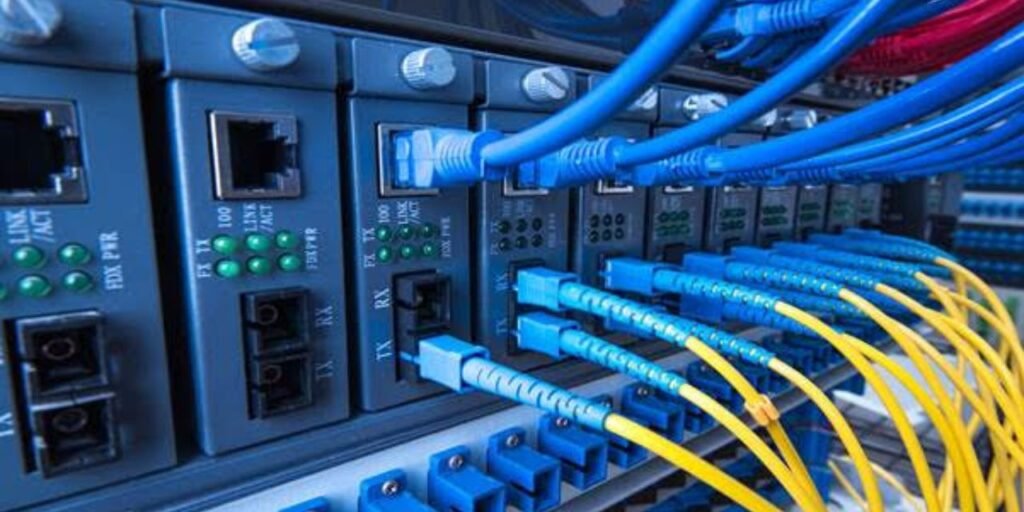
Introduction
The rapid expansion of hyperscale data centers, driven by the increasing need for cloud services, artificial intelligence (AI), and the Internet of Things (IoT), is reshaping the global data center switch market. As businesses increasingly adopt digital transformation strategies and move their operations to the cloud, the demand for robust and scalable networking solutions has surged. At the heart of these transformations are data center switches, which are responsible for facilitating high-speed data transfers and managing complex network infrastructures within large-scale data centers.
This blog explores the growing demand for data center switches, with a particular focus on hyperscale data centers. We will examine key trends, technological advancements, and market dynamics that are fueling the adoption of these essential networking devices. Global sales of Data Center Switches in 2021 totaled a valuation of US$ 13.8 billion. Over the next ten years, worldwide data center switches demand is set to rise at 4.8% CAGR. At the end of 2032, the global data center switch market size will reach around US$ 23.2 billion as per report published by Persistence Market Research.
The Rise of Hyperscale Data Centers
Hyperscale data centers are large-scale facilities designed to support the expansive needs of companies offering cloud-based services, including giants like Amazon Web Services (AWS), Google Cloud, Microsoft Azure, and Facebook. These data centers have unique characteristics, including:
- Massive Scalability
Hyperscale data centers are designed to scale up rapidly to meet the growing demands of cloud computing, AI, and big data analytics. With the explosive growth of data and the increasing reliance on cloud infrastructure, these centers require highly scalable and flexible networking solutions. - High Efficiency and Performance
Efficiency is paramount in hyperscale data centers. These centers are built to provide maximum uptime, reduce operational costs, and support the heavy computational loads required by cloud services, AI models, and enterprise applications. Data center switches play a critical role in maintaining performance while ensuring high throughput and low latency. - Cost-Effectiveness
Given their large size, hyperscale data centers focus on cost-efficiency in every aspect of their operations. By optimizing power consumption, cooling systems, and network components, these facilities can support vast amounts of data with minimal overhead.
The Role of Data Center Switches in Hyperscale Data Centers
Data center switches are integral to managing data traffic within data centers. They connect various devices, servers, and storage units and ensure data flows seamlessly between them. In the context of hyperscale data centers, the requirements for switches are heightened due to the massive scale and complexity of these networks. Here’s how data center switches facilitate hyperscale operations:
- High Bandwidth and Low Latency
Hyperscale data centers handle vast amounts of data every second. Data center switches must provide high bandwidth to manage traffic and low latency to ensure real-time data processing. Low-latency performance is particularly critical for applications such as cloud gaming, video streaming, and real-time analytics. - Scalability
The ability to scale quickly is essential in hyperscale data centers. As these facilities expand to accommodate increasing workloads, data center switches must support growing network demands without compromising performance. This requires switches with flexible architecture that can be easily upgraded and expanded. - Redundancy and Fault Tolerance
Given the critical nature of hyperscale data centers, redundancy is essential to ensure uninterrupted service. Data center switches are designed to provide failover mechanisms, enabling traffic to be rerouted in case of failure, thereby ensuring high availability and minimal downtime. - Software-Defined Networking (SDN)
SDN allows for greater flexibility in managing data center networks by decoupling the control plane from the data plane. This enables better network automation, simplified management, and dynamic resource allocation—essential in hyperscale environments where traffic patterns can change rapidly.
Market Trends Driving the Demand for Data Center Switches in Hyperscale Data Centers
Several key trends are contributing to the growing demand for data center switches in hyperscale data centers:
- Cloud Adoption and Digital Transformation
The global shift toward cloud computing and digital transformation is a primary driver of demand for hyperscale data centers. As more businesses migrate to the cloud, the need for robust, high-performance networking solutions to support these large-scale infrastructures increases. Data center switches enable this transition by supporting the heavy traffic demands of cloud applications. - Increase in AI and Machine Learning Workloads
AI and machine learning (ML) are becoming increasingly prevalent in enterprise and consumer applications. These technologies require massive computational power and data storage, placing significant strain on data center networks. Data center switches are vital to supporting the high-speed data transfers required for these workloads, enabling efficient AI model training and deployment. - Edge Computing Expansion
As more devices become connected through IoT, the need for edge computing has risen. Edge data centers are smaller and closer to end-users, providing faster processing times for latency-sensitive applications. Hyperscale data centers are expanding to support edge infrastructure, and this has resulted in an increased demand for high-capacity switches to manage data flows between central and edge locations. - 5G Deployment
The rollout of 5G technology is another significant factor driving the growth of hyperscale data centers. 5G networks require advanced data handling capabilities to support ultra-low latency and massive data throughput. Data center switches with the ability to handle these high-performance demands are essential in supporting the 5G ecosystem. - Increasing Data Volumes
The continued growth of big data, driven by industries like healthcare, finance, retail, and entertainment, is putting additional pressure on data centers. As data volumes grow exponentially, hyperscale data centers must adopt more sophisticated networking solutions to ensure that data flows efficiently and securely.
Technological Advancements in Data Center Switches
The data center switch market has witnessed several advancements in recent years, aimed at meeting the unique demands of hyperscale environments:
- 40/100/400G Switches
High-speed switches, such as 40G, 100G, and 400G Ethernet switches, are now widely used in hyperscale data centers. These switches provide the high bandwidth needed to support large-scale data transfers across vast networks. - Optical Switching
As data volumes continue to surge, optical switching is becoming more prevalent in hyperscale data centers. Optical switches use light-based signals for data transmission, offering faster speeds and higher bandwidth compared to traditional electronic switches. - Network Automation
With the increased complexity of hyperscale data center networks, automation has become essential. AI and machine learning-driven automation tools help manage traffic, optimize performance, and troubleshoot issues in real-time, minimizing human intervention and operational costs. - AI-Driven Network Management
AI and machine learning are transforming the way data center networks are managed. By analyzing network data in real-time, AI can predict traffic patterns, identify potential bottlenecks, and optimize the overall performance of data center switches.
Key Players in the Data Center Switch Market
The data center switch market is highly competitive, with several major players leading the charge in the development and deployment of advanced networking solutions for hyperscale data centers. Some of the key players include:
- Cisco Systems, Inc.
Cisco is a market leader in networking equipment, offering a wide range of switches designed for hyperscale data centers. The company’s portfolio includes both traditional switches and next-generation software-defined solutions. - Arista Networks, Inc.
Arista Networks specializes in high-performance switches for large-scale data centers, focusing on scalability and low-latency performance. Arista’s switches are widely used in hyperscale environments for cloud and data center interconnects. - Juniper Networks, Inc.
Juniper Networks offers high-capacity switches designed for data centers, with a focus on automation, security, and performance. The company’s products are tailored to meet the demands of hyperscale cloud providers and large enterprises. - Huawei Technologies Co., Ltd.
Huawei is a global leader in telecommunications and networking equipment, offering cutting-edge switches that cater to the needs of hyperscale data centers, including support for high-bandwidth, low-latency applications.
Conclusion
The data center switch market is poised for significant growth, driven by the increasing demand for hyperscale data centers. These centers are critical to supporting the expanding needs of cloud computing, AI, 5G, and big data. As the demand for high-performance, scalable, and cost-effective networking solutions grows, data center switches will continue to play a pivotal role in ensuring the smooth functioning of hyperscale infrastructures.
Consumer awareness around the importance of high-speed, low-latency, and secure networking will continue to fuel the growth of the data center switch market. As technology continues to evolve, we can expect further advancements that will enable data centers to meet the challenges of the digital age efficiently.
